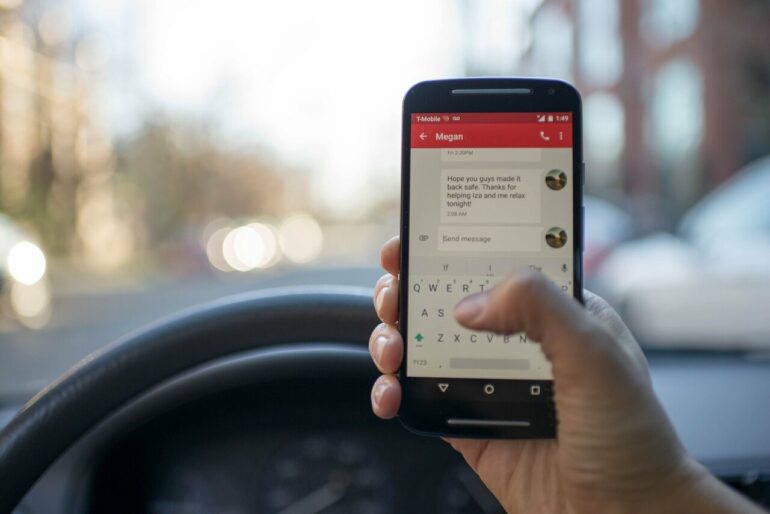To make someone put their phone down while driving, show them the money—with a catch, according to research published in JAMA Network Open. When a group of auto insurance customers were tempted with a cash incentive—and regular feedback letting the driver know how they were doing compared to other drivers trying to reduce their phone time—handheld phone use dropped significantly, a team at the Perelman School of Medicine at the University of Pennsylvania found.
The researchers examined several different strategies informed by behavior science to curb distracted driving in a seven-week trial. One strategy paired weekly feedback on phone use with a cash incentive of up to $50 at the end of the study if the drivers used their phones less than others.
That approach yielded a 15% decrease in handheld phone usage compared to drivers given no incentive or feedback. However, when drivers were told that they would receive the same amount of money paid out in weekly installments, but lose it if they engaged in handheld phone usage while driving, phone use decreased by 21%.
“In the United States, there are over 800,000 crashes per year due to distracted driving, with cell phone use while driving being a leading cause. This occurs despite numerous laws banning handheld phone use, suggesting additional scalable interventions are needed,” said lead author M. Kit Delgado, MD, MS, faculty director of Penn Medicine’s Nudge Unit and an associate professor of Emergency Medicine and Epidemiology.
“We were able to use the power of humans’ natural aversion to loss and regret, as well as our desire to fit in to social norms, to achieve some significant results.”
Insurance companies saw a 30% climb in distracted driving-related crashes between 2011 and 2020, largely tied to cell phone usage. Twenty-eight states have passed bans on handheld phone usage while driving, with Pennsylvania the latest state to enact a law, which takes effect mid-2025.
The practice of incentivizing drivers’ behaviors is rising. Auto insurance companies are increasing “usage-based insurance (UBI)” where customers agree to download smartphone apps to monitor driving performance and cell phone usage. The data is then used to adjust rates for individual drivers, with safer drivers being offered discounts on future insurance policies.
For the study, Penn Medicine researchers worked with researchers at Progressive Insurance, which invited customers participating in their own UBI program to participate, enrolling over 2,000 participants in the study.
With deidentified data, Penn Medicine’s researchers determined that a group of drivers who were told (and updated weekly) that they could lose up to $7.15 a week were the ones who used their phones least compared to the control group of drivers that had no incentives or feedback.
Interestingly, doubling the incentive to $14.29 per week didn’t lead to a greater reduction in phone use, though there was a significant decline. There were also notable results among drivers who received feedback and were offered the $50 incentive at the end of the test period.
Drivers offered the delayed $50 incentive at the end of the intervention but received no weekly feedback and no incremental loss for weekly performance did not achieve significant results.
The reason why feedback and loss-framed payments appeared to be so critical, Delgado believes, is innately human.
“People tend to think they are better drivers than others,” he said. “Providing objective data on how they compare to others is a proven way to motivate people toward a social norm. Also, prior studies have shown that those who engage in handheld phone use tend to have ‘present bias’ and place stronger weight on payoffs that are closer to the present time.”
When broken down into time, the top achieving intervention—the $7.15-per-week group—lowered their phone usage by an average of 56 seconds per hour down from a baseline of 216 seconds per hour. When taking one’s eyes off the road for 5 seconds increases the risk of crash nine-fold, at scale, these interventions could reduce distracted driving by millions of hours per year.
This work continues research performed by Delgado into distracted driving dating back to 2016 (which led to a 2018 paper) and continues with further nudge data analysis. Future research includes testing interventions leveraging smartphone usage data that could help high-risk drivers build lasting habits.
“This line of work is promising because insurance companies already spend billions of dollars per year offering incentives for safe driving behaviors,” said Delgado. “Rigorously testing strategies these companies can use to engage customers to be safer can help reduce crashes, save lives, and save money, and, importantly, be sustained through a strong business case.”
More information:
JAMA Network Open (2024)
Provided by
Perelman School of Medicine at the University of Pennsylvania
Citation:
Feedback plus cash incentives reduce phone use while driving, researchers discover (2024, July 10)



